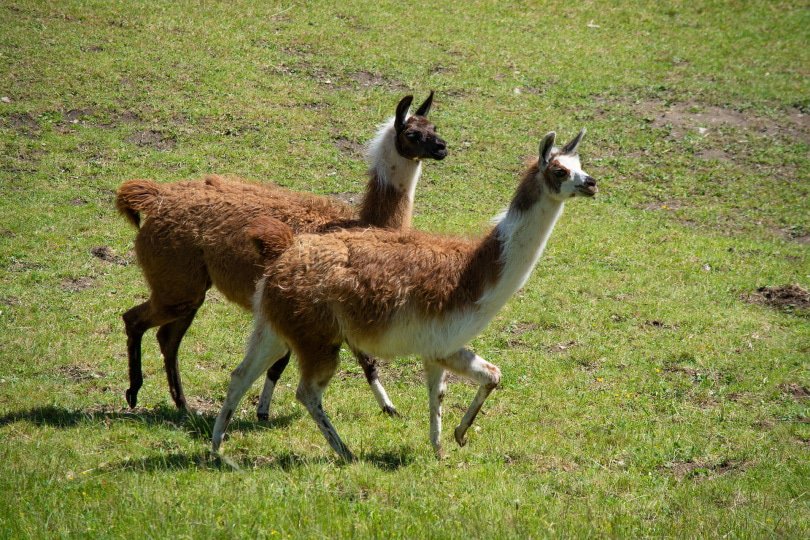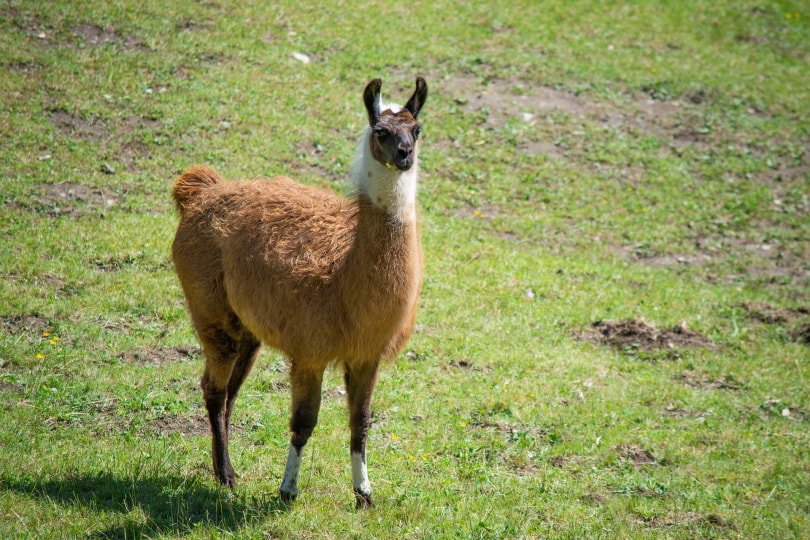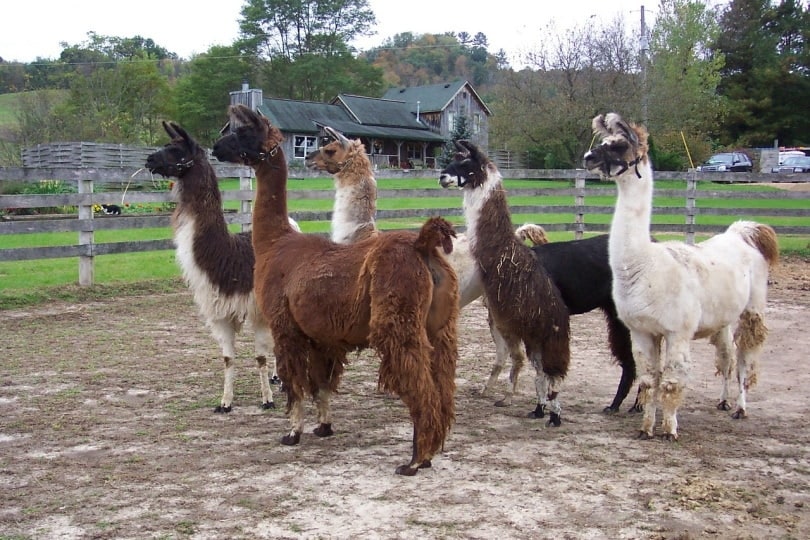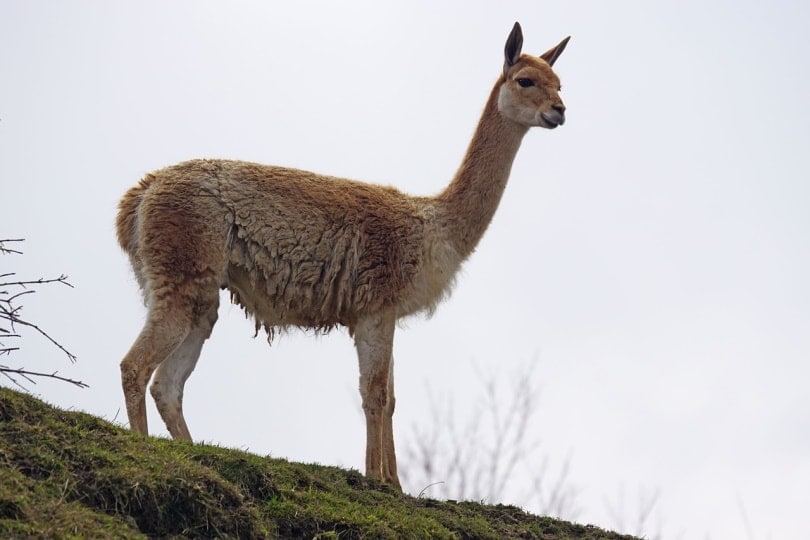Llamas are social animals that an increasing number of people are choosing to keep on their farms as pets. One reason these animals are chosen as pets is the fact that they’re hearty and relatively easy to care for.
In all, there are five different types of llamas including the Classic llama, Wooly llama, Medium llama, Suri llama, and Vicuna llama with each being unique in size and characteristics. For example, the Classic llama is smaller and has less hair than the Wooly llama that’s covered in thick fleece.

Facts About the Llama
Llamas are big animals weighing in at around 300 pounds. This means if you’re planning on getting a llama, you must have enough space available both for your llama to graze and to shelter it from the weather.
As a pack animal, a llama makes a great guard for herds of small animals. It will adopt a group of goats or sheep as its own herd and warn them of any perceived danger like an approaching predator. A llama isn’t a quiet animal as it makes all kinds of sounds ranging from low hums to loud clicking noises to express how it feels.
Llamas are very well adapted to rough environments thanks to their thick coats and unique feet. Each foot consists of two large toes with pads on the underside. The soft and sensitive pads help a llama easily traverse rocky and uneven land.
These quirky, curious, long-necked animals are often confused with Alpacas which are their close relatives as both are classified as camelids as are camels. If you’re wondering how big llamas get, you’ve come to the right place! Continue reading to find more about the size of llamas.

Llama Size and Growth Chart
As mentioned above, there are five different types of llamas. Because the Classic llama can withstand nearly all types of weather and it’s a popular one to keep as a pet, we’ve represented that llama in our size and growth chart below.
A llama is smaller than a camel and bigger than an alpaca. While you may have ample room to keep a young llama, that animal will grow quickly and before you know it, be a large animal that needs at least 40 square feet of indoor living space to bed down at night. An adult llama also requires a fence that’s at least 4 feet high to keep it safely contained when it’s outdoors during the daytime hours. This is why we recommend taking a close look at the chart below, so you’ll know how big a llama gets according to its age.
| Age | Weight Range | Length Range | Height |
| Birth | 18-20 pounds | 1-2 feet | 2.5-3 feet |
| 18 months to 3 years | 290-440 pounds | 4-7 feet | 5.7-5.9 feet |

When Does a Llama Stop Growing?
You may be surprised to learn that llamas grow from the time they’re born to about the time they turn 3 years of age. You can expect a young llama to build a considerable amount of muscle, bone, and skin and put on around a pound of body weight a day up until its third birthday. This means you must ensure you have plenty of space to house your growing llama so it grows up to be a happy and healthy animal.
Factors Affecting the Size of Llamas
Like with other animals, there are a few factors that affect the size of llamas. First and foremost, the size a llama will be when it grows into adulthood is partially determined by the type of llama it is. The smallest type of llama is the Vicuna llama that grows to be anywhere from 86-140 pounds and stands just about 2.8 feet tall. The biggest of the bunch is the Wooly llama that can tip the scale at over 400 pounds and be 6 feet tall.
Nutrition is another factor that determines how big a llama will be. A llama that’s undernourished may not grow to its full potential. Conversely, a well-fed llama will receive all the nutrients it needs to grow big and strong. Other factors that can come into play include the overall health of the llama and how well-adjusted it is to living in captivity.

Ideal Diet for Maintaining a Healthy Weight
A llama can become fat from eating the wrong foods so it’s important to provide a pet llama with a well-balanced diet. Look for a commercial llama food that contains the right balance of vitamins, minerals, carbs, fats, and proteins to keep your llama healthy. A top-quality llama food will provide your animal with the ideal diet that’s low in sugar and starch levels.
It’s fine to give your llama a treat now and then as long as the treat is llama-friendly and healthy. A few foods you use as llama treats include:
- Carrots
- Celery
- Pumpkin
- Sweet Potato
- Apple
- Alfalfa
- Green Beans
- Apples
- Watermelon
- Mulberries
Never feed a llama human treats like cookies, cakes, or chips of any kind. Just use your common sense, allow your llama to graze, and don’t overdo it with the treats!

How to Measure Your Llama
A great way to keep tabs on how much your llama is growing is to measure the animal regularly. Of course, this task will be much easier if your llama behaves itself so make sure you tame that beast so it cooperates with you!
A terrific product to use for measuring your llama is something called a weight tape. This is simply a measuring tape you put around the animal’s girth that will tell you your llama’s weight in pounds on one side and its height on the reverse. It’s a great way to keep tabs on your llama’s growth rate and weight. Even though most weight tapes are made for horses and ponies, they work for any animal that weighs between 80 and 1400 pounds.

Conclusion
Llamas not only look and act silly, but these noble creatures also make wonderful additions to small-scale farms. If you’re interested in getting a llama, be sure you have the space the animal will need. Even if you get a young llama that isn’t very big, that little guy is going to grow into a large animal that needs plenty of room both indoors and out!
Featured Image Credit: Piqsels
